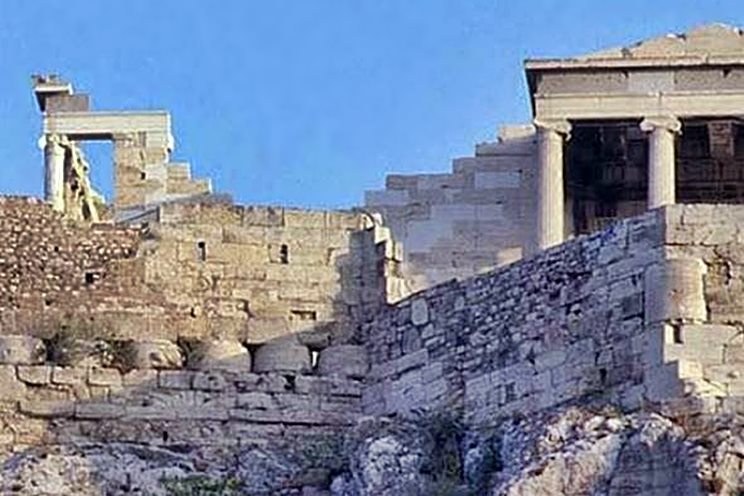Athens, Athens, Attica
Acropolis of Athens
| Location: |
| Athens |
| Region > Prefecture: |  |
| Attica Athens | |
| Municipality > Town: | |
| City of Athens • Athens | |
| Altitude: | |
|
Elevation ≈ 156 m (Relative Height≈70 m) |
| Time of Construction | Origin | |
| various periods | ANCIENT |
|
| Castle Type | Condition | |
| Castle |
Average
|
Athens, apart from its glorious history of the classical period, was during the Middle Ages, also, one of the most important cities in the world. Acropolis was its castle. And it remained a castle until the end of the Turkish occupation.
The Acropolis of Athens is a rocky hill at an altitude of 156 m above sea level. At the top of the hill there is a trapezoidal plateau 300m long, with a maximum width of 150m, with a total area of about 25,000 sq.m. The plateau was protected by a fortification with a perimeter of almost 700 meters.
The hill is steep and inaccessible on all sides except the west, where the main gate of the castle was located, which was protected by the Propylaia.
History
Because of its convenient morphology, the Acropolis has been a refuge since prehistoric times. The first, so-called Cyclopean wall, was built along the top of the hill in the Mycenaean period, at approximately 1200 BC. Remains of this wall are still visible to the southeast of the Propylaia, while its course can be traced fairly accurately.
The main entrance to the fortress was on the west side, at Propylaia, next to a bastion, which later supported the temple of Athena Nike.
This Mycenaean wall remained in use with minor repairs and changes until 480 BC, when it was severely damaged by the Persians. However, during the classic period Acropolis was not a fort, but rather a place of religious importance, a so called “holy rock”.
After the end of the Persian wars, both the city of Athens and the Acropolis were given new walls. The northern, or Themistoclean, wall was the first to be built using material from the monuments destroyed by the Persians. North of the Erechtheion one may notice the marble drums of the Pre-Parthenon, while further to the west are fragments from the entablature (cornices, triglyphs and metopes) from the Old temple of Athena. The southern, or Kimonean, wall was erected under Kimon after the victory at Eurymedon in 467 BC. The wall's construction necessitated the creation of a terrace along the south edge of the hill. It, too, used building material from the Old temple and the Pre-Parthenon.
After the catastrophic Herulian invasion in 267 AD, another wall was built west of the Propylaia. Of its two gates, only the west one, the so-called Beule gate, stands to this day. The Acropolis became a fortress once again and was used as such until the 19th century.
During the Byzantine period, most ancient buildings were demolished except the Erechtheion, the Propylaia and the Parthenon which became a Christian church. Sometime during this era, the characteristic buttresses were added to the perimeter of the wall for better support of the fortification.
During the frankokratia (the Frankish rule), Acropolis became the seat of the Duchy of Athens. Two towers were added in this period (perhaps in the 13th century). One of them was at the eastern side, at the “Belvedere” point where the flagpole stands today. The other was protecting the gate at the western side. It was an imposing 26m high tower that during the Turkish period was used as a prison. This tower was demolished in 1874.
The southeast corner of the fortification wall was repaired one last time after the Second World War.
| First entry in Kastrologos: | July 2021 |
Sources
- Website ΟΔΥΣΣΕΥΣ - Greek ministry of Culture, Acropolis fortification wall
- Wikipedia - Acropolis of Athens
|
|
| Access |
|---|
| Entrance: |

















